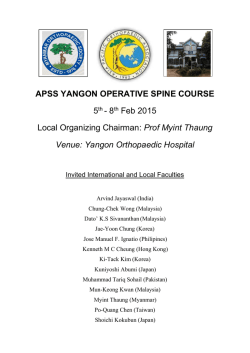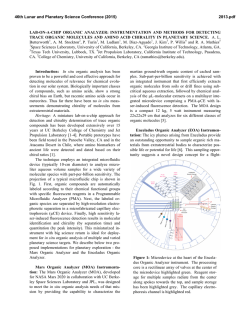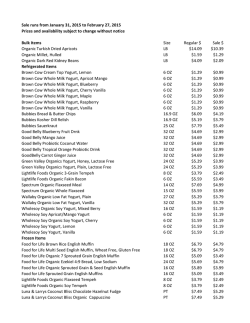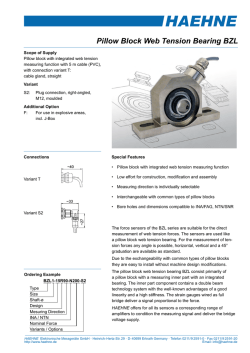
Effect of temperature on surface properties of
Effect of temperature on surface properties of cervical tissue homogenate and organic phase monolayers A. Preetha a , R. Banerjee a,∗ , N. Huilgol b a School of Biosciences and Bioengineering, Indian Institute of Technology, Bombay, Mumbai 400076, India b Division of Radiation Oncology, Nanavati Hospital, Mumbai, India Abstract The temperature dependence of Langmuir monolayers of normal and cancerous human cervical tissues and their organic phases between temperatures of 37 and 45 ◦ C was evaluated. Analysis of the surface pressure–area isotherms revealed significantly different increase in fluidity of the cancerous cervical tissue monolayer at 42 ◦ C as opposed to the normal cervical tissue monolayers (p < 0.05). Similarly, in the case of cervical cancerous organic phase monolayers significant increase of fluidity was observed at 40 ◦ C whereas no such change was observed in the normal cervical organic phase monolayers. The effect of temperature was found to be different in cancerous and normal cervical tissues and this may be due to the different lipid profiles in them. Cancerous cervical tissues had 1.8-fold higher total lipids as compared to the normals. Similarly, the PC, PE, PI, PG, SM and PS levels in cancerous cervical tissues were 3.6, 2.0, 2.3, 4.7, 1.7 and 2.2 times higher than those of normal cervical tissues, respectively. Significant cancer–normal difference in minimum surface tension and hysteresis area was found at all temperatures studied for both tissue homogenates and organic phases. For example, cancerous tissue homogenates showed minimum surface tensions of 51.9 ± 4.6, 54.4 ± 5.9, 57.6 ± 6.0 and 51.9 ± 5.6 mN/m at temperatures 37, 40, 42 and 45 ◦ C whereas the corresponding values for normal cervical tissue homogenates were 39.3 ± 3.6, 39.2 ± 3.7, 39.2 ± 3.8 and 39.1 ± 3.6, respectively. The fluidity change at hyperthermic range of temperature can be correlated to the increased efficiency of drug on combination therapy with hyperthermia. These results may have implications in manipulating the fluidity of cervical cancer tissue membranes for better permeability thereby leading to better therapeutic strategies for cervical cancer. Keywords: Tissue tensiometry; Surface pressure–area isotherm; Temperature; Hysteresis; Hyperthermia; Cervical cancer 1. Introduction Cervical cancer is one among the leading cause of cancer mortality in women [1]. Presently multimodal treatment of cancer is gaining attention and hyperthermia is being widely explored as an adjunct to radiotherapy and chemotherapy. A review by Hildebrandt et al. [2] reported that several clinical trials have demonstrated improved survival rates for pelvic tumor patients treated with combined radiotherapy and hyperthermia. A phase II study reported an improved outcome of a triple modality treatment, involving cisplatin, radiotherapy and hyperthermia, in patients having advanced cervical cancer and a phase III trial of the same for cervical cancer is on [3]. These literature evidences suggest the role of hyperthermia in cervical cancer treatment. Hyperthermia is the treatment of malignant diseases by the application of heat. Clinically relevant hyperthermic temperature range is between 40 and 43 ◦ C [2,4]. Hyperthermia itself has been shown to be cytotoxic and several chemotherapeutic agents in combination with hyperthermia have shown additive cytotoxic effects [5–7]. Temperature has the ability to perturb biological membranes. For example, non-lethal doses of temperature produced a remodeling of the composition and alkyl chain unsaturation of membrane lipids in E. coli which manifested as membrane fluidization and permeabilization [8]. Monolayers at an air–liquid interface are convenient models for understanding the behavior of many natural self-organized systems like biological membranes because they allow simulation of biological conditions [9]. Hence Langmuir monolayers are selected as model systems for monitoring the surface properties of cancerous and normal cervical membranes with respect to the change of temperature in this study. 13 Kazakov et al. [10] showed that the dynamic surface tension (with respect to time) of serum from cervical cancer patients was lower as compared to that of normals. During radiotherapy, the surface tension was found to shift towards that of normals. Thus, it was shown that interfacial tensiometry of human biological fluids provided data with the potential to differentiate various pathologies and to monitor the treatment processes. Recently, the surface tension of astrocytoma tissue aggregates was found to be related to the invasive potential of the cancers [11]. Studies by Foty et al. [12] have established that dexamethasone treatment of HT-1080 human fibrosarcoma cells caused a 2.5-fold higher cell cohesivity or surface tension which was correlated with a reduced invasiveness of the tumors. Surface tension measurements of lung carcinoma cell aggregates also demonstrated the role of cadherins in suppression of invasion [13]. However, these studies do not use Langmuir monolayers for evaluation of surface properties. Our earlier studies using Langmuir monolayers at 37 ◦ C, established significantly lower surface activity of cancerous cervical tissue homogenate monolayers as compared to the normal cervical tissue homogenate monolayers. Similarly, the surface activity of normal cervical organic phase was found to be significantly lower as compared to the cancerous cervical organic phase [14]. This paper deals with the effect of temperature on the surface properties of the normal as well as cancerous cervical tissue homogenate and their organic phase monolayers. The temperatures evaluated were 37, 40, 42 and 45 ◦ C as they are the clinically relevant temperatures for the hyperthermia treatment of cancer. 2. Experimental details 2.1. Collection, preparation and extraction of tissue Human biopsy specimens of cervical cancerous tissues (n = 15) and normal cervical tissues (n = 15) were obtained from the Radiation Oncology Division of Nanavati Hospital, Mumbai, India. The use of human tissue biopsies was approved by the ethical committee of the hospital. All cancerous samples were collected prior to any treatment. All cases were of stage III squamous cell carcinoma of cervix. Normal controls were obtained from hysterectomy patients having non-cervical disorders. All the normal cases were reported to be free from malignancy by the histopathology analysis and the cervical portion was normal. Equal weights and equal number of cells of cancerous and normal tissues were homogenized for evaluation. All the tissue samples were washed thoroughly with normal saline, dried on a tissue paper and weighed. The weighed samples were processed by using liquid nitrogen and dissolved in measured volumes of normal saline to get a tissue homogenate of known concentration. The tissue homogenate was kept at −10 ◦ C till experimentation and all the experiments were performed within 10 days of sample collection. It was confirmed that the surface activity of fresh and stored tissue homogenate was not altered within 10 days. The organic phases containing the lipophilic components and the aqueous phases containing the lipophobic parts of the tissue homogenates were separated by using Bligh–Dyer extraction procedure [15]. Briefly, 0.8 ml of the tissue homogenate was treated with chloroform and methanol in the ratio 1: 2 (v/v) and agitated well to get a single phase. To this 1: 1 (v/v) chloroform: water was added and agitated well for 5 min followed by centrifugation at 100 × g for 10 min, to achieve good phase separation. The separated organic phases were stored at −10 ◦ C till experimentation. All measurements were conducted within 24 h of extraction. 2.2. Laboratory chemicals HPLC grade methanol and chloroform (for tissue extraction purpose), HPLC grade potassium hydroxide and ammonium molybdate were purchased from Loba chime, Mumbai, India. AR grade methanol and acetone for cleaning of Langmuir trough and potassium dihydrogenphosphate for phosphorus assay standard were purchased from SRL, Mumbai, India. Phosphatidylcholine for testing the accuracy of phosphorus assay and cholesterol for cholesterol assay standards were obtained from Sigma-Aldrich Co. (St. Louis, USA). High purity water purified by a Milli Q Plus water purifier system (Milli pore, USA), with a resistivity of 18.2 M cm, was used for all experiments. 2.3. Lipid quantification The quantification of total lipid, total cholesterol, total phospholipid and individual phospholipids in cancerous and normal cervical tissues was also performed. Gravimetric method was used for the determination of the amount of total lipids extracted from cervical tissues. The total cholesterol content was quantified by a colorimetric assay using ortho-phthalaldehyde in glacial acetic acid and concentrated sulphuric acid. The total phospholipid content was quantified by malachite green phosphorus assay [14]. The separation of individual phospholipids from the tissue extracts was done by modified touchstone’s thin layer chromatographic (TLC) method and the individual phospholipid quantification was done by phosphorus assay after separation by TLC [16]. 2.4. Monolayer experiments Monolayer studies were performed by using a computer controlled LB film balance (KSV Mini trough model, KSV Instruments, Finland). The trough is placed on an antivibration table, which is enclosed by an environmental chamber. The Teflon coated trough is equipped with two delrin barriers (for monolayer compression and expansion) and the entire trough is surrounded by a water jacket, providing temperature control. A Wilhelmy plate balance with a platinum plate (19.62 mm × 10 mm) is used for sensing the surface pressure. Before each monolayer experiment, the trough and barriers were thoroughly cleaned by organic solvents (methanol and acetone) and deionized water in sequence several times. Highly pure deionized water, having resistivity 18.2 M cm, was the subphase in all experiments. The surface pressure–area isotherms were recorded at temperatures 37, 40, 42 and 45 ◦ C. The temperature of the subphase was maintained at the desired value with the help of an external circulating water bath and the variation of 14 the temperature during the course of experiment was ±0.5 ◦ C. The surface was cleaned with the help of an aspirator and a zero reading of the surface pressure ensured the cleanliness. One milligram of tissue homogenate/organic phase (100 l of 10 mg/ml solution) was spread as tiny droplets on the surface of the subphase using a Hamilton syringe. In the case of organic phase, 30 min wait time was given for the evaporation of the organic solvents. The surface pressure–area isotherms were recorded by continuous compression and expansion of the monolayer for three cycles (1 cycle = 1 compression + 1 expansion) with a barrier speed of 120 mm/min. The maximum relative area change during compression was 86.5% and the surface pressure was measured with a sensitivity of 0.004 mN/m. Table 1 Lipid profiles of cancerous and normal human cervical tissues Lipids Represented as mg/g of tissue Cancerous Total lipid Total phospholipid Cholesterol Phosphatidylcholine Phosphatidylethanolamine Phosphatidylinositol Phosphatidylglycerol Phosphatidylserine Sphingomyelin 60.55 4.83 23.02 1.44 0.40 0.82 0.61 0.48 1.03 ± ± ± ± ± ± ± ± ± 0.04* 0.08* 0.28* 0.03* 0.03* 0.06* 0.02* 0.01* 0.02* Normal 33.15 1.94 15.45 0.40 0.20 0.36 0.13 0.22 0.61 ± ± ± ± ± ± ± ± ± 0.02 0.04 0.09 0.01 0.01 0.02 0.02 0.02 0.01 Values expressed as mean ± standard deviations. * Represents significantly different values from the normal controls (p < 0.05). 2.5. Calculation of parameters From the surface pressure–area isotherms obtained, the following parameters were calculated. The minimum surface tension (γ min ) was calculated as γ min = γ s − πmax where πmax is the maximum surface pressures and γ s is the surface tension of the sub phase. The hysteresis area ( G) is the difference between the free energy of compression and free energy of expansion which are calculated from the area under the corresponding surface pressure–area isotherms. The effect of temperature on γ min and G of the monolayers was evaluated in this study. 2.6. Statistical analysis Fifteen human cervical cancerous tissues and 15 normal human cervical tissues were characterized in this study and for each monolayer; tensiometric parameters were calculated as explained. The data are expressed as mean ± standard deviation. The effect of temperature on cancerous and normal tissue homogenates and their organic phases was compared by Student’s t-test at 95% confidence level. A paired t-test was used as the tensiometric profile of same tissue was evaluated at different temperatures ranging from 37 to 45 ◦ C. A statistical comparison of the surface activity of cancerous and normal cervical tissues at each of the temperatures studied was performed by unpaired Student’s t-test at 95% confidence level. Fig. 1 depicts the surface pressure–area isotherms of cancerous and normal human cervical tissue homogenate monolayers at different temperatures. In Fig. 1, all the isotherms are means of 15 tissue homogenate data. The reproducibility of the surface pressure–area isotherms was checked by repeated recordings and the relative standard deviation in surface pressure was found to be ≤2%. The shape of the isotherm was not significantly affected by the increase of temperature in both cancerous and normal tissue homogenates. The normal tissue homogenate isotherms showed an increase in surface pressure from 90% area of compression at all temperatures studied. On the other hand, the cancerous tissue homogenate isotherms showed horizontal regions till 55% area of compression at all temperatures studied. Characterization of the organic phase monolayers of cancerous and normal cervical tissues was also done at different temperatures. The mean surface pressure–area isotherms of organic phases of cancerous and normal cervical tissues at various temperatures are shown in Fig. 2. The mean compression isotherm of the cancerous organic phase showed an increase in surface pressure at the beginning of compression but the normal organic phase isotherms showed a similar rise below 70% area that is on further compression. 3. Results The lipid levels of cancerous and normal cervical tissues are summarized in Table 1. One can find 1.8-fold higher total lipids in cancerous cervical tissues as compared to the normals. Similarly, the total phospholipid and total cholesterol content of the cancerous cervical tissue was 2.5- and 1.5-fold higher than that of the normal tissue, respectively. All the individual phospholipids quantified in this study were found to be higher in cancerous cervical tissues compared to normal tissues. The phosphatidylcholine (PC), phosphatidylethanolamine (PE), phosphatidylinositol (PI), phosphatidylglycerol (PG), phosphatidylserine (PS) and sphingomyelin (SM) levels in cancerous cervical tissues were 3.6, 2.0, 2.3, 4.7, 2.2 and 1.7 times higher than those of normal cervical tissues, respectively. Fig. 1. Surface pressure–area isotherms of cervical tissue homogenates at different temperatures. All the isotherms are means of 15 tissue homogenate data from first compression isotherms. 15 Fig. 2. Surface pressure–area isotherms of cervical tissue organic phases at different temperatures. All the isotherms are means of 15 organic phase data from first compression isotherms. Fig. 3 shows the effect of temperature on minimum surface tension of cancerous and normal cervical tissue homogenates. The normalized minimum surface tensions with respect to the value at 37 ◦ C have been plotted against the temperature. For all cancerous tissue homogenates the normalized minimum surface tension shows a maximum value at 42 ◦ C. Significant elevation in minimum surface tension of cancerous tissue homogenates was observed on rise of temperature from 37 to 42 ◦ C whereas no significant change in minimum surface tension was found in normal tissue homogenate at these temperatures as evidenced by t-test at 95% confidence level. The effect of temperature on minimum surface tension of organic phases of cancerous and normal cervical tissues has been depicted in Fig. 4. The minimum surface tension achieved at 40 ◦ C was significantly higher that that at 37 ◦ C for all the 15 cancerous organic phase samples. In case of normal cervical organic phase, no significant change in minimum surface tension was observed on rise of temperature from 37 to 45 ◦ C as indicated by the near unity values of normalized minimum surface tension at all temperatures studied. The bar diagram in Fig. 5 compares the minimum surface tension values of tissue homogenates and organic phases in cancerous and normal cervical tissues at various temperatures. As can be seen from Fig. 5, the minimum surface tension of cancerous tissue homogenate was significantly higher than that of the normal tissue homogenate at all temperatures studied (p < 0.05). In case of organic phases, the minimum surface tension of the cancerous organic phase was significantly lower than that of the normal cervical organic phase at all temperatures studied. Table 2 depicts the effect of temperature on hysteresis area of cancerous and normal tissue homogenates and their organic phases. In cancerous and normal tissue homogenate monolayers, the hysteresis area was not significantly affected by a rise in temperature from 37 to 45 ◦ C. Similar result was also observed in case of the cancerous and normal organic phase monolayers. However, the hysteresis area of the cancerous tissue homogenate monolayers was significantly lower than that of the normal ones at all temperatures studied. In case of organic phases, the hysteresis area of cancerous organic phase was significantly higher than that of the normals at all the temperatures studied as evidenced by t-test (p < 0.05). 4. Discussion Plateaus were observed in the surface pressure–area isotherms of cancerous tissue homogenates and normal organic phases above 55 and 70% areas, respectively, at all temperatures studied (Figs. 1 and 2). These plateaus denote the gaseous to liquid expanded phase transitions in these monolayers. These plateaus were unaltered at all the temperatures studied. In normal tissue homogenates and cancerous organic phases, an increase in surface pressure was observed from ∼90% area of compression indicating molecular ordering on film compression. This Fig. 3. Effect of temperature on minimum surface tension of cancerous and normal cervical tissue homogenate monolayers. Each point represents a surface pressure–area isotherm recorded at that specified temperature and each curve represents a tissue sample. 16 Fig. 4. Effect of temperature on minimum surface tension of cancerous and normal cervical organic phase monolayers. Each point represents a surface pressure–area isotherm recorded at that specified temperature and each curve represents an organic phase from a tissue sample. Fig. 5. Comparison of minimum surface tension of tissue homogenates and organic phases in cancerous and normal tissues at various temperatures. Values represented as mean ± standard deviation of 15 sample data. was unaffected by the rise of temperature within the range of 37–45 ◦ C. Minimum surface tension represents the maximum possible monolayer packing. The higher the γ min , more fluid will be the monolayer. The γ min values of cancerous and normal tissue homogenates indicate that the normal tissue homogenate monolayer is more fluid than the cancerous tissue homogenate. However, the opposite is true in case of the cancerous and normal organic phase monolayers. Significant differences in γ min values indicate the change in molecular ordering and molecular interactions of the monolayer components [17,18]. From Fig. 3 it can be observed that the minimum surface tension was significantly higher at 42 ◦ C than that at 37 ◦ C for the cancerous tissue homogenates. This suggests a fluidizing effect of temperature in cervical cancerous tissue homogenate monolayers at 42 ◦ C. No such effect was observed in the normal cervical tissue homogenate monolayers. The cancerous organic phase monolayers had a higher minimum surface tension at 40 ◦ C compared to that at 37 ◦ C. This suggests a fluidizing effect Table 2 Effect of temperature on hysteresis area of cervical monolayers Monolayers 37 ◦ C Cancerous tissue homogenate Normal tissue homogenate Cancerous organic phase Normal organic phase 16.7 90.3 78.9 31.4 ± ± ± ± 40 ◦ C 7.8* 17.7 9.6* 6.8 16.9 88.9 86.3 39.8 ± ± ± ± 42 ◦ C 7.8* 14.5 10.2* 7.9 Values expressed as mean ± standard deviations. * Represents significantly different values from the normal controls at the same temperature (p < 0.05). 20.1 91.2 79.8 40.6 ± ± ± ± 45 ◦ C 9.0* 11.6 11.6* 10.6 18.4 87.0 81.3 38.9 ± ± ± ± 9.2* 10.1 16.7* 9.6 17 in cancerous organic phase at 40 ◦ C. No change in minimum surface tension was observed in the normal organic phases at all the temperatures studied. The significantly different surface activities of cancerous and normal tissues between 37 and 45 ◦ C suggest a fluidizing effect at 42 ◦ C in cervical cancerous tissue homogenates which may be of relevance in hyperthermia. An increase in fluidity of the cell membrane due to hyperthermia has also been reported in the literature [2]. The effect of temperature on cancerous and normal cervical monolayers was found to be different. This may be due to the composition differences of the cancerous and normal monolayers. The lipid profiles in the cancerous and normal cervical tissue was found to vary as described in Table 1. Membrane lipids are reported to play a remarkable role in thermosensitivity and thermotolerance of mammalian cells [19]. The lipid profiles in normal and cancerous cervical tissues may influence the effect of temperature on the tissue homogenate and organic phase monolayers. The acyl chain composition was found to significantly affect the temperature dependence of Langmuir monolayers of sphingomyelin between 10 and 30 ◦ C [20]. If a change in acyl chain of a lipid could produce remarkable difference in thermotropic behavior of the lipid monolayer, then the difference in lipid profile may produce different surface properties for mixed monolayers, like the ones in the present study, with respect to temperature. Cervical cancerous tissue homogenates had lower surface pressure and hence a higher minimum surface tension than that of normal tissue homogenates at all temperatures studied (Fig. 5). This suggests that cervical cancerous tissue homogenates formed more fluid monolayers than their normal counter parts. Similarly, membranes of lung cancerous tissues have been reported to be more fluid than the corresponding normal tissues and high plasma membrane fluidity of lung tumors has been associated with a poor prognosis [21,22]. However, in case of organic phases this trend is reversed and the higher surface activity or lower minimum surface tension of the organic phase of cervical cancerous tissue as compared to normal at all temperatures studied, may be explained by the higher amounts of surface active lipids in the cancerous organic phase. The organic phase of cervical cancerous tissues was more surface active than that of the normals whereas the normal cervical tissue homogenate was more surface active than the cancerous tissue homogenate. This result suggests that not only the surface active lipids but also interaction between the lipid and non-lipid components of the tissue determines its surface activity. Reproducible hysteresis area across compression–expansion cycles represents the slow respreading of the molecules on expansion. A higher hysteresis area is indicative of a condensed phase of the monolayer [23]. In this study hysteresis area was reproducible across cycles. An increase of temperature from 37 to 45 ◦ C did not significantly change the hysteresis area in any of the monolayers studied. This indicates that the stability of the condensed phase of the monolayers was not significantly affected by temperature rise from 37 to 45 ◦ C. However, the hysteresis area of cancerous tissue homogenate was significantly lower compared to that of the normal tissue homogenates, indicating the lower stability of the cancerous tissue homogenate monolayers as compared to the normal controls. The hysteresis area values also revealed the higher stability of the cancerous organic phase monolayers as compared to normal organic phase monolayers. 5. Summary The minimum surface tension of cancerous tissue homogenates was significantly higher at 42 ◦ C than at 37 ◦ C. No such increase in minimum surface tension was observed in normal tissue homogenates between temperatures of 37 and 45 ◦ C. This increased surface tension due to higher temperature may be of relevance in hyperthermia. In case of organic phases, the minimum surface tension of cancerous organic phase was significantly higher at 40 ◦ C than that at 37 ◦ C. No such effect was observed in normal organic phase monolayers between temperatures of 37 and 45 ◦ C. The increase in minimum surface tension observed in cancerous tissue homogenates and organic phases at temperatures of 42 and 40 ◦ C, respectively, could be indicative of an increased fluidity at these temperatures and may be correlated to the increased efficacy of chemotherapy when combined with hyperthermia. Such changes in surface tension and fluidity at 40–42 ◦ C may have relevance to the response of the tissues to hyperthermia. In short, the results of this study may have implications in manipulating the fluidity of cervical cancerous membranes to improve the efficacy of hyperthermia based therapeutic strategies in cervical cancer. Acknowledgments We thank Dr. Priti D. Galvankar and Dr. Ketaki R. Shah of Nanavati Hospital, Mumbai, India for their help in collection and pathological analysis of cervical tissues. References [1] V.G. Reddy, N. Khanna, N. Singh, Biochem. Biophys. Res. Commun. 282 (2001) 409. [2] B. Hildebrandt, P. Wust, O. Ahlers, A. Dieing, G. Sreenivasa, T. Kerner, R. Felix, H. Riess, Crit. Rev. Oncol./Hematol. 43 (2002) 33. [3] P. McCaffrey, Lancet Oncol. 6 (2005) 642. [4] M.L. Hauck, M.W. Dewhirst, M.R. Zalutsky, Nucl. Med. Biol. 23 (1996) 551. [5] M.W. Dewhirst, L. Prosnitz, D. Thrall, D. Prescott, S. Clegg, C. Charles, J. Macfall, G. Rosner, T. Samulski, E. Gillette, S. Larue, Semin. Oncol. 24 (1997) 616. [6] G.M. Hahn, J. Braun, I. Har-Kedar, Proc. Natl. Acad. Sci. 72 (1975) 937. [7] T.S. Herman, B.A. Teicher, M. Jochelson, J. Clark, G. Svensson, C.N. Coleman, Int. J. Hyperthermia 4 (1988) 143. [8] N. Shigapova, Z. T¨or¨ok, G. Balogh, P. Goloubinoff, L. V´ıgh, I. Horv´ath, Biochem. Biophys. Res. Commun. 328 (2005) 1216. [9] R. Maget-Dana, Biochim. Biophys. Acta, Biomembr. 1462 (1999) 109. [10] V.N. Kazakov, A.F. Vozianov, O.V. Sinyachenko, D.V. Trukhin, S.V. Lylyl, A.M. Belokon, U. Pison, Colloids Surf. B 21 (2001) 231. [11] B.S. Winters, S.R. Shepard, R.A. Foty, Int. J. Cancer 114 (2005) 371. [12] R.A. Foty, S.A. Corbett, J.E. Schwarzbauer, M.S. Steinberg, Cancer Res. 58 (1998) 3586. [13] R.A. Foty, M.S. Steinberg, Cancer Res. 57 (1997) 5033. [14] A. Preetha, N. Huilgol, R. Banerjee, Biomed. Pharmacother. 59 (2005) 491. 18 [15] E.G. Bligh, W.J. Dyer, Can. J. Biochem. Physiol. 37 (1959) 911. [16] A. Preetha, R. Banerjee, N. Huilgol, Surface activity, lipid profiles and their implications in cervical cancer, J. Cancer Res. Thera. 1 (2005) 180– 186. [17] D. Vollhardt, V. Fainerman, Colloids Surf. A 176 (2001) 117. [18] M.S. Aston, T.M. Herrington, J. Colloid Interf. Sci. 141 (1991) 50. [19] A.W. Konings, A.C. Ruifrok, Radiat. Res. 102 (1985) 86. [20] X. Li, J.M. Smaby, M.M. Momsen, H.L. Brockman, R.E. Brown, Biophys. J. 78 (2000) 1921. [21] M. Sok, M. Sentjurc, M. Schara, Cancer Lett. 139 (1999) 215. [22] M. Sok, M. Sentjurc, M. Schara, J. Stare, T. Rott, Ann. Thor. Sur. 73 (2002) 1567. [23] G.O. Rafael, O.C. Reyna, M. Bruno, Biochim. Biophys. Acta 1370 (1998) 127.
© Copyright 2025







